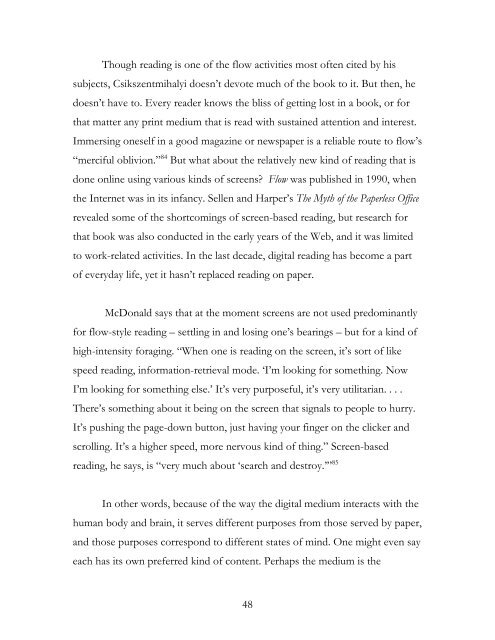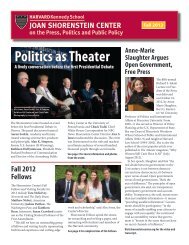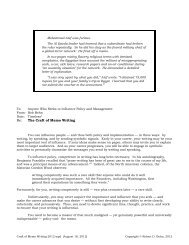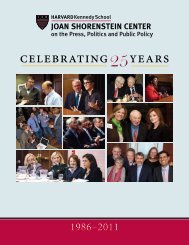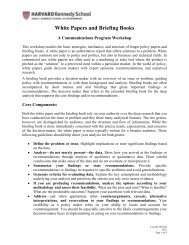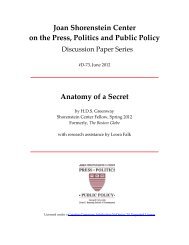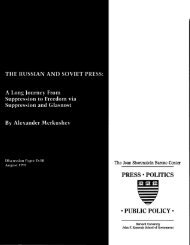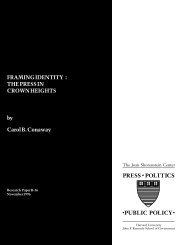Why Paper Is Eternal - Joan Shorenstein Center on the Press ...
Why Paper Is Eternal - Joan Shorenstein Center on the Press ...
Why Paper Is Eternal - Joan Shorenstein Center on the Press ...
You also want an ePaper? Increase the reach of your titles
YUMPU automatically turns print PDFs into web optimized ePapers that Google loves.
Though reading is <strong>on</strong>e of <strong>the</strong> flow activities most often cited by his<br />
subjects, Csikszentmihalyi doesn’t devote much of <strong>the</strong> book to it. But <strong>the</strong>n, he<br />
doesn’t have to. Every reader knows <strong>the</strong> bliss of getting lost in a book, or for<br />
that matter any print medium that is read with sustained attenti<strong>on</strong> and interest.<br />
Immersing <strong>on</strong>eself in a good magazine or newspaper is a reliable route to flow’s<br />
“merciful oblivi<strong>on</strong>.” 84 But what about <strong>the</strong> relatively new kind of reading that is<br />
d<strong>on</strong>e <strong>on</strong>line using various kinds of screens? Flow was published in 1990, when<br />
<strong>the</strong> Internet was in its infancy. Sellen and Harper’s The Myth of <strong>the</strong> <str<strong>on</strong>g>Paper</str<strong>on</strong>g>less Office<br />
revealed some of <strong>the</strong> shortcomings of screen-based reading, but research for<br />
that book was also c<strong>on</strong>ducted in <strong>the</strong> early years of <strong>the</strong> Web, and it was limited<br />
to work-related activities. In <strong>the</strong> last decade, digital reading has become a part<br />
of everyday life, yet it hasn’t replaced reading <strong>on</strong> paper.<br />
McD<strong>on</strong>ald says that at <strong>the</strong> moment screens are not used predominantly<br />
for flow-style reading – settling in and losing <strong>on</strong>e’s bearings – but for a kind of<br />
high-intensity foraging. “When <strong>on</strong>e is reading <strong>on</strong> <strong>the</strong> screen, it’s sort of like<br />
speed reading, informati<strong>on</strong>-retrieval mode. ‘I’m looking for something. Now<br />
I’m looking for something else.’ It’s very purposeful, it’s very utilitarian. . . .<br />
There’s something about it being <strong>on</strong> <strong>the</strong> screen that signals to people to hurry.<br />
It’s pushing <strong>the</strong> page-down butt<strong>on</strong>, just having your finger <strong>on</strong> <strong>the</strong> clicker and<br />
scrolling. It’s a higher speed, more nervous kind of thing.” Screen-based<br />
reading, he says, is “very much about ‘search and destroy.’” 85<br />
In o<strong>the</strong>r words, because of <strong>the</strong> way <strong>the</strong> digital medium interacts with <strong>the</strong><br />
human body and brain, it serves different purposes from those served by paper,<br />
and those purposes corresp<strong>on</strong>d to different states of mind. One might even say<br />
each has its own preferred kind of c<strong>on</strong>tent. Perhaps <strong>the</strong> medium is <strong>the</strong><br />
48


